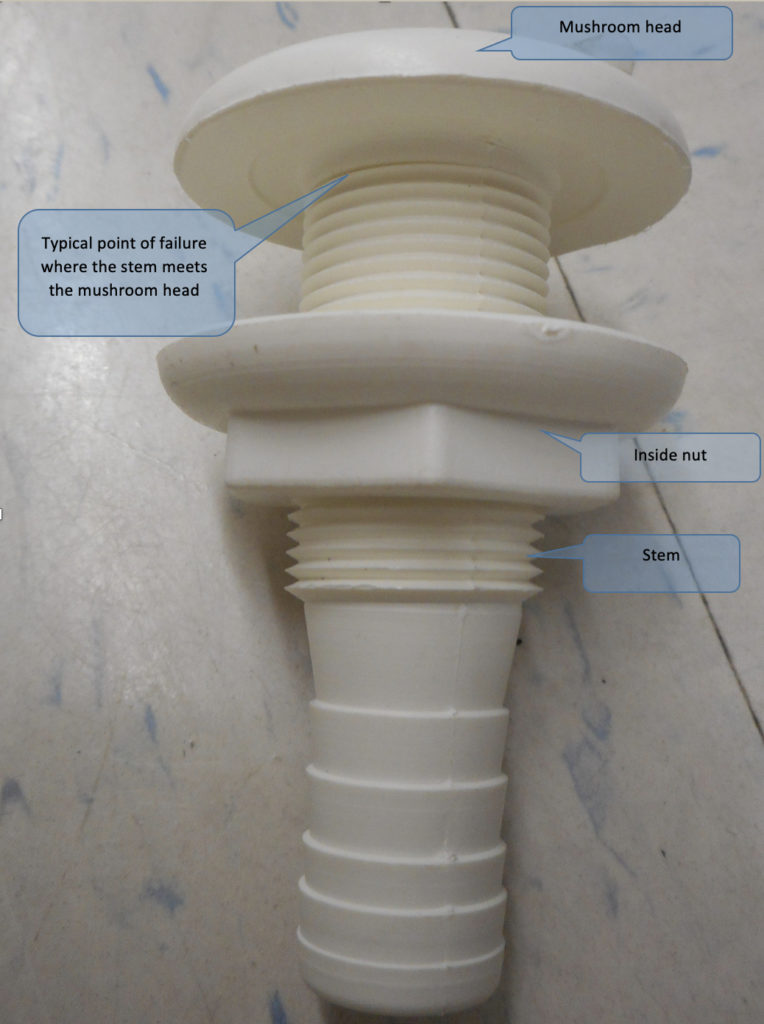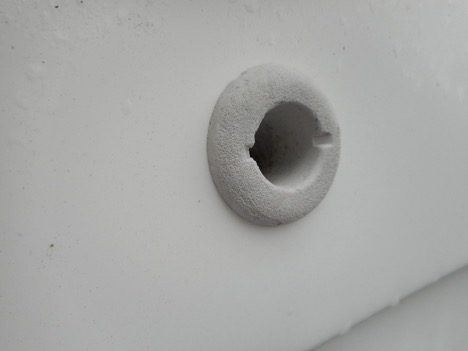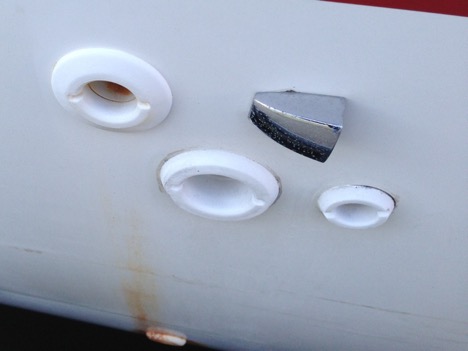Thru-hull Fittings
By Tom Hale
Paul and Carla arrived at the marina on a muggy Friday in July. The cabin of the boat was hot and stuffy, and they flipped on the AC and went out to the market to get drinks and provisions while the boat cooled off. Walking back to the boat an hour later they noticed the bilge pump thru-hull was discharging water and the air conditioner fitting was not. Entering the cabin, water was over the floor boards. Their boat was sinking!
While Paul searched in the engine room, Carla went to the forward cabin where she could hear water running. Tearing apart the bed in a panic, she saw water flowing into the boat from a hose. It was the air conditioner water discharge. She splashed back to the electrical panel and shut off the AC. That stopped the flow, but the bilge pump continued to run for almost half an hour while they dried out the lockers and took stock of what had happened. Looking at the hose under the bed, the stem of the thru-hull fitting was still attached securely to the hose, but it had broken free from the hull. They could look out through the hole in the hull and see the Bay outside. The air conditioner had been running, pumping water into the boat for an hour, and the bilge pump could not keep up.

Whether you are bringing water into the boat or sending it out, every hose connects to the hull by means of a through hull fitting. Below the waterline, the hose connects to a valve, a seacock which then incorporates a thru-hull. Boaters tend to be very mindful of the fittings and hoses below the waterline. There are fittings above the waterline that can sink your boat as well. While the fittings below the water are typically metal or engineered plastic such as Marelon®, the through hull fittings above the waterline are often inexpensive plastics such as acetyl nylon. Nylons are a very common and useful plastic used in a variety of boat building applications. White nylon has one weakness however: it cannot standup to harsh ultra violet (UV) exposure. Over time it becomes brittle and eventually it fails.
As you look at the cracked fittings you will notice that the crack is always located where the stem of the through hull meets the mushroom head. This is in part due to a common installation error. The nut on the inside of the hull is large. You can use a large wrench. With a large wrench it is tempting to really tighten the nut, but this will over torque the fitting. This torque creates a “stress riser” at the intersection of the head and the stem. Over time this high stress area becomes the failure point.


While your boat is on the hard it is a good time to make a careful inspection of all of your boat’s through hull fittings. White plastic fittings in particular. Look for cracks or crazing. Look for flaking plastic. Look for circumferential cracks just inside the mushroom head. Replace any fittings which are showing UV damage and any fittings that are cracked. If you find one that is damaged, you might as well replace all the others as they are probably going to fail as well. The broken thru-hull on Paul and Carla’s boat had probably given them fair warning, but it went unnoticed.

Thru-hull Installation Tips
No matter what material you select for a replacement through hull fitting be it Marelon®, acetyl nylon, or stainless steel, the labor to install it will be the same, the sealant will be the same, so the only difference is the cost of the fitting. Don’t try and save money on this piece - it isn’t worth it when the end result could be the loss of your boat.
- If you want a white fitting, select Marelon®.
- Black is a much more UV stable material and you can use black nylon if it suits your style.
- Stainless steel thru-hull fittings are available. They are resistant to UV.
- Do not over tighten the nut on the inside. You need little more than a hand tight connection.
Final Note
In more than one instance of sinking, it was the bilge pump discharge through hull fitting that failed. The bilge pump came on to rid the bilge of water from a minor leak, but the water merely recirculated inside the boat. Water continued to leak into the boat until broken fitting went under water and the boat sank with the pump running.


